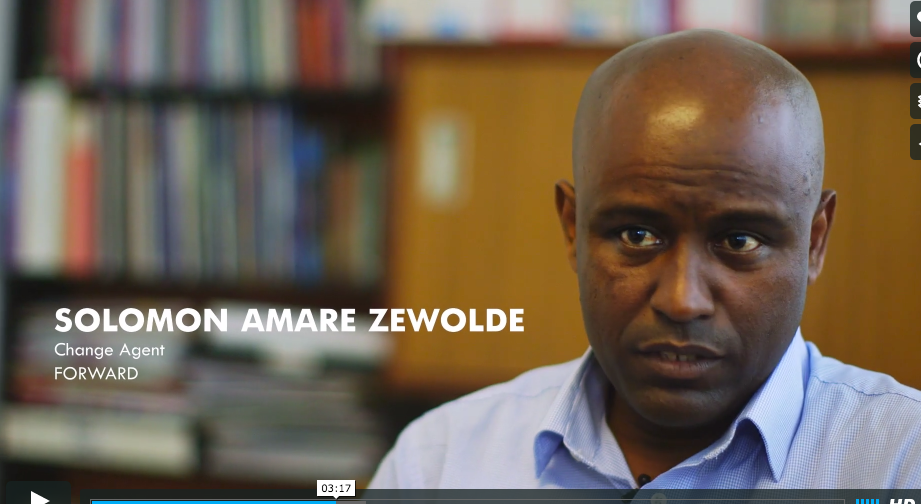Introducing The FGM/C Policy Advocate Care Fund
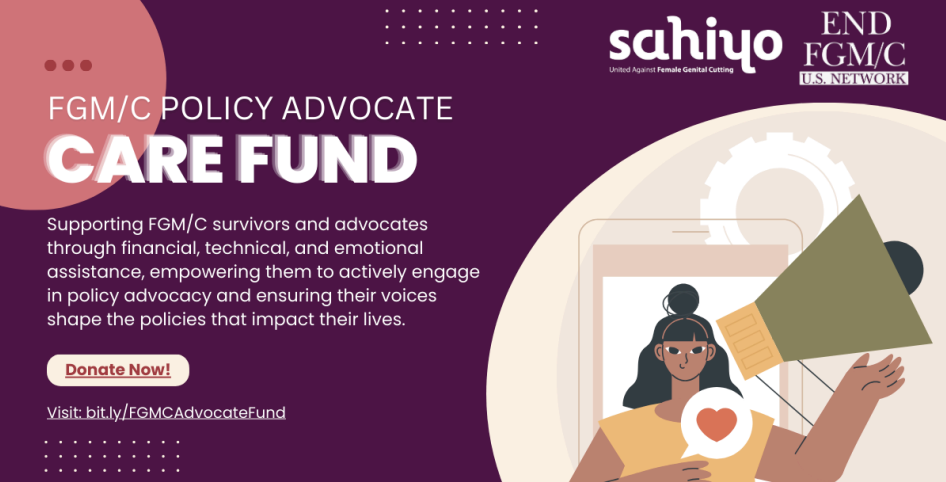
The newly established FGM/C Policy Advocate Care Fund provides vital resources and support to those tirelessly working to prevent FGM/C and support survivors. Created through a partnership between Sahiyo U.S. and the U.S. End FGM/C Network, this fund aims to: Empower survivors and individuals from communities impacted by FGM/C Enable survivors, activists, and advocates to actively engage in education and policy advocacy Ensure that activists are fairly compensated for their contributions, recognizing that they are often overlooked and underfunded. Advocates working to end FGM/C face numerous challenges including resistance from communities, lack of resources, and risks to their health and mental well being. Finding ways to support these advocates can help ensure individuals can continue their vital work to end FGM/C, effectively and safely. The goal of the fund is to empower activists, advocates, and survivors to create meaningful change in their communities and end this harmful practice. Your donation is essential in sustaining the critical work of advocates dedicated to ending FGM/C. By donating to The FGM/C Policy Advocate Care Fund, you’re directly empowering advocates, ensuring they have the financial, technical, and emotional support necessary to continue their impactful work. Your contribution strengthens their capacity, safeguards their well-being, and creates lasting change in the world. Donate Here. (P.S. don’t miss out on our upcoming event, “4 Essential Strategies for Self and Community Care in Activism,” with Farzana Doctor, on Tuesday, September 10th at 9:00 AM PST/ 12:00 PM EST. Register Here.)
Calling on the CT legislature to protect girls from FGM/C
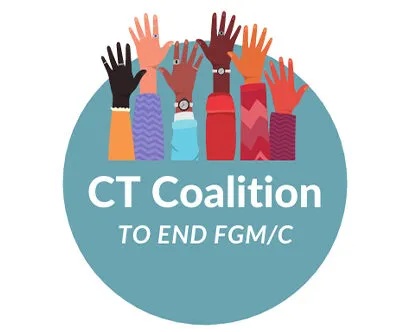
A bill to protect children from female genital mutilation/cutting (FGM/C) in Connecticut (CT) has not been raised by the Connecticut Judiciary Committee in the 2024 legislative session. This news comes as a shock to many survivors of FGM/C and anti-FGM/C activists who have been campaigning for the bill to be introduced. The bill would have been sponsored by Rep. Jilian Gilchrest (D), and would have created education and outreach programs, issued civil remedies for survivors, and created better access to healthcare for survivors of FGM/C. Additionally, the bill would have made it clear that FGM/C is a criminal offense in Connecticut. Currently, Connecticut is only one of nine states left in the U.S. that have no explicit legal protections against FGM/C. Over 2,600 girls are at risk of experiencing FGM/C in Connecticut. Around the country, over half a million women and girls are at risk or are survivors of the practice, according to the Centers for Disease Control and Prevention. Additionally, Connecticut is surrounded by states that have outlawed the practice including New York and Massachusetts. By not following suit, Connecticut could become a safe haven for people who are seeking to practice FGM/C on girls from other states where the practice is illegal. Let’s urge the Connecticut legislature to prioritize the passage of this crucial legislation because every girl deserves to grow up safe and empowered. Join us in advocating for the protection of girls from female genital mutilation/cutting (FGM/C) by calling on your representatives in Connecticut to take action. Your support is crucial in safeguarding the rights and well-being of vulnerable children in Connecticut. Sign this call to action now! For more information, please visit the CT Coalition website.
Volunteer spotlight: Editorial Intern Cecilia Mwakenya
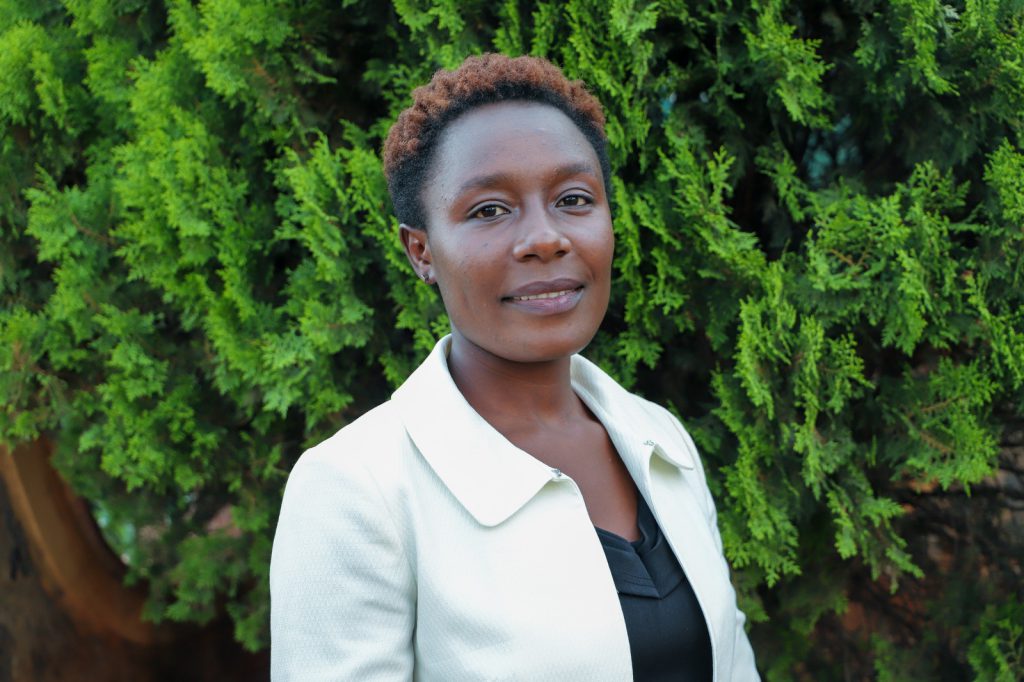
Cecilia Mwakenya is a journalist, and a recent graduate from Rural Aid Kenya, where she pursued a diploma in communications (broadcast option). Previously, she worked as a social media volunteer at Tunza Dada, as well as a news reporter at Hekima FM and the Kenya Broadcasting Corporation (KBC). Cecilia is passionate about women and girl’s empowerment and has been telling human interest stories on human rights and education. She is excited to work with Sahiyo to help end female genital cutting among Asian and other communities. What was your experience of learning about female genital cutting (FGC) for the first time like? My first time encountering FGC was when I was thirteen years old. Growing up, I had no idea FGC existed, despite the fact that it was all around me. It was a surprising and terrifying experience because I learned about it from someone who went through the cut. I felt so bad and it left me with a strong desire to learn more about FGC, which is where my need to fight against FGC began. When and how did you first get involved with Sahiyo? I’ve known about Sahiyo since I was in school, when I was doing research for a project about FGC. In January 2023, I applied for the role of Editorial Intern. I was delighted to see an organization that shares the same values and interests looking for someone to support their work. I have a background in communications journalism, where I enjoy telling human interest stories as well as empowering women and girls to be better members in society. What does your work with Sahiyo involve? I work on writing blog posts, assisting with editing , transcribing interviews for research and the blog, and fact-checking when needed. How has your involvement with Sahiyo impacted your life? Joining Sahiyo has been amazing. I feel so passionate about the work and the organization. Working with a team of supportive, strong, and hardworking women makes me feel so confident that I am in the right place with the right people. Since the day I joined Sahiyo, it has challenged me to grow career-wise and be confident.I feel really inspired, and I am proud of who I am becoming. I am so happy and lucky that I am working with Sahiyo, as it grows I also grow and learn. What words of wisdom would you like to share with others who may be interested in supporting Sahiyo and the movement against FGC? Sahiyo is the right place to be. It gives you hope and sees the best in you. If you have the skills and you are passionate about Sahiyo, joining will be valuable to you because you will leave feeling motivated and empowered.
Sahiyo co-founder curates a week-long Twitter discussion on FGC

From July 3 to July 7, Sahiyo co-founder Aarefa Johari was invited to curate @MuslimVoicesIN, a Twitter handle run by a group of progressive Indian Muslims. The handle celebrates the plurality of Muslim identities in India and discusses different topics relevant to Indian Muslims each week. Aarefa was invited to curate a discussion on Female Genital Cutting among Bohra Muslims. Since Bohras are a small minority sub-sect, the topic came as a shock to many of the other Indian Sunnis and Shias who participated in the week-long discussion. In the span of five days, Aarefa curated eight threads discussing various aspects of FGC: an explanation of what FGC is, the relevance of the clitoris, the reasons given for performing FGC, its health consequences, the alarming trend of medicalisation, the debates surrounding FGC-related terminology and laws on FGC, and the contentious issue of parental rights. The Twitter discussions elicited a mixed response. Many Muslims were upset that FGC was being misinterpreted as an “Islamic” practice by Bohras, and dismissed it as a topic irrelevant to “mainstream Muslims”. However, many others were eager to learn more about a topic they had little knowledge of. To read Aarefa’s discussion on FGC on @MuslimVoicesIN, click here.
Dec 7: Join our Twitter chat on Type 1 Female Genital Cutting in Asia
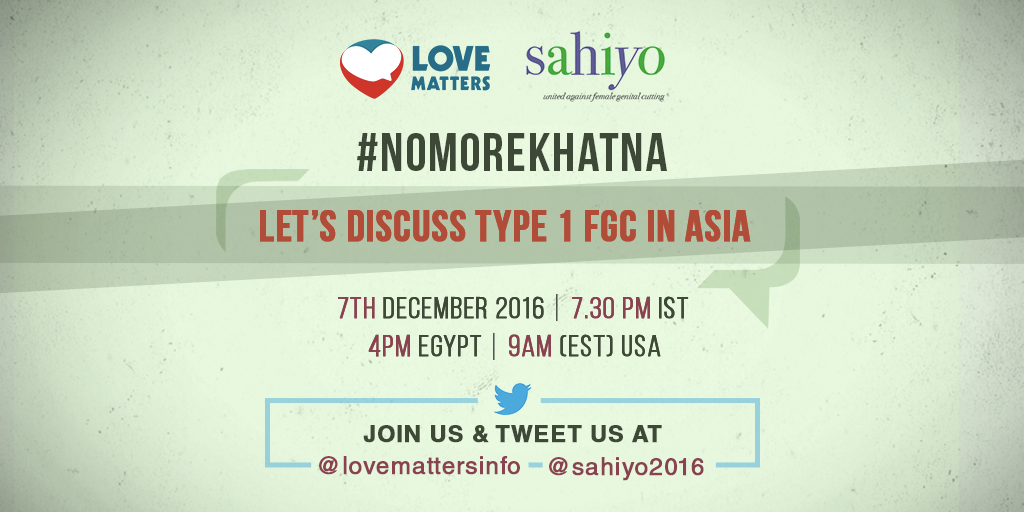
Female Genital Cutting is practiced in many different ways, some less severe than others. But is a woman’s experience of such a ritual any less significant if the cutting was “mild”? Love Matters India and Sahiyo would love to discuss this question – and many others – with all of you in a Twitter Chat on Wednesday, December 7, 2016. Timings: The Twitter Chat begins at 7.30 pm IST (India and Sri Lanka) 9 am EST (US east coast) 4 pm in Egypt 10 pm in Singapore and Malaysia Here is how you can participate: Log into your Twitter account (or make one, if you are not on Twitter yet!) Follow the handles @lovemattersinfo and @sahiyovoices Respond to our questions and tweets about Type I FGC Remember to use the hashtag #NoMoreKhatna in all your tweets! Why this discussion is important: According to United Nations statistics, at least 200 million girls from 30 countries around the world have been subjected to Female Genital Cutting / Mutilation (FGC/M), a practice that involves cutting away varying degrees of the female genitalia. The World Health Organisation classifies FGC into four types, depending on how severe the cut is. For decades, activists, researchers, funders, and the media have focused mainly on Types II and III, the most severe forms of genital cutting. Type I, however, has often been overlooked. This form involves cutting the clitoral hood, and/or part or all of the clitoris, and it is prevalent in a number of Asian communities, including the Dawoodi Bohras and Malay Muslims. All too often, concerns about this “mild” form of genital cutting are dismissed as overreactions. “It is just a small nick, a small slice of skin,” we are told. “It is not the same as the mutilation done in Africa,” they say. We believe it is time to re-examine these notions about Type I FGC, to give voice to those who have been affected, and to recognise that even the least severe genital cuts are still a form of gender violence. And as a prequel to the Twitter Chat, do watch this video by Love Matters India and director Priya Goswami, featuring Bohra voices of resistance to Type I FGC: [youtube url=”https://youtu.be/A5F6OT5vwwY”]
Proud to present: ‘A Small Nick or Cut, they say…’
‘All FGM causes trauma and pain’: A great video speaking of FGM/C as a collective struggle.
